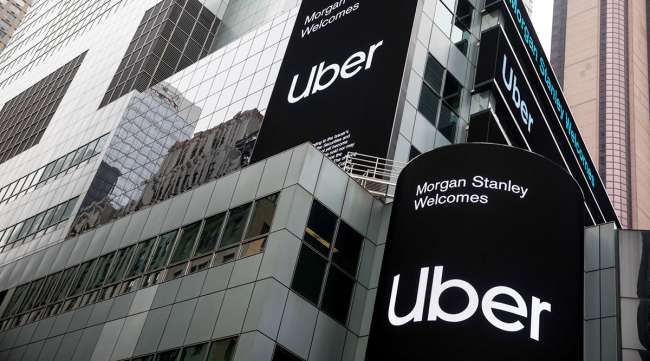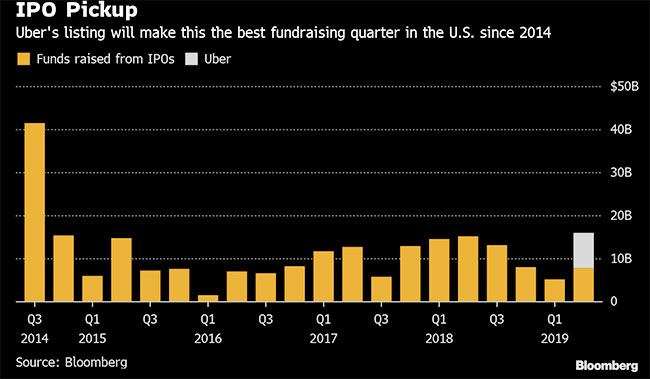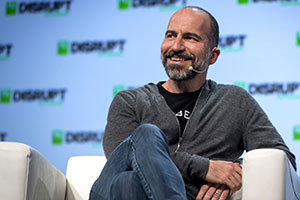Uber’s Conservative IPO Valuation Faces Public Market Test

Uber Technologies Inc. took a conservative approach to its initial public offering May 9, picking a share price toward the bottom of the marketed range and at a valuation below its last private funding round. On May 10, public market investors will get to decide whether that was a good idea.
The No. 1 ride-hailing company’s shares will start trading on the New York Stock Exchange after it raised $8.1 billion in the biggest U.S. IPO since 2014, pricing shares at $45 each. It had marketed them for $44 to $50 apiece.
Austin Geidt, an early Uber employee who joined the company in 2010 and works in its autonomous vehicles division, rang the NYSE opening bell May 10 alongside executives as well as Uber drivers from Los Angeles, London and Sydney. While a video showing how Uber operates around the world played on big screens, ousted co-founder Travis Kalanick watched from a nearby balcony with his father beside him.
U.S. equities fell for a fifth day at the start of regular trading May 10, with Uber’s biggest rival, Lyft Inc., dropping less than 1% to $55.06 in New York. Uber is hoping to avoid the tumultuous first weeks of trading that dogged its competitor, which trades about 24% below its IPO price.
In distributing the stock, Uber prioritized shareholders — particularly institutional investors — that it thinks will hold on to the shares for a long time, according to a person familiar with the matter.

Based on the amount of stock outstanding after the offering, Uber’s IPO price gives the San Francisco-based company a market value of $75.5 billion. Its last private market value was $76 billion. The fully diluted value in the IPO, including restricted stock units and other shares, could be about $82 billion.
“We view Uber’s conservative pricing as a smart and prudent strategy coming out of the box as it clearly learned from its ‘little brother’ Lyft, and the experience it has gone through over the past month,” Wedbush Securities analyst Dan Ives said. Uber’s biggest competitor briefly dipped below its last private value of $15.1 billion in pre-market trading May 9.
Even at the low end of the price range, Uber’s listing will be the ninth-largest U.S. IPO of all time and the biggest on a U.S. exchange since Alibaba Group Holding Ltd.’s $25 billion global record holder in 2014, according to data compiled by Bloomberg. Since the 2008 financial crisis, only two other U.S. IPOs have topped it: Facebook Inc.’s $16 billion 2012 listing and General Motors Co.’s $18 billion offer in 2010 after its bailout by the U.S. government.
Delighted to share this moment with the drivers and delivery-partners that changed the way the world moves. pic.twitter.com/2SZxIjdBbs — Uber (@Uber) May 10, 2019
Still, it’s a considerable climb down from earlier projections: Last year, bankers jockeying to lead the offering told Uber it could be valued at as much as $120 billion in an IPO.
That’s partly because, after waiting a decade to go public, the most highly valued startup in the United States is set to make its market debut amid less-than-ideal conditions. The S&P 500 index is on pace for its worst week of the year as trade tensions between the United States and China dominated global politics, with President Donald Trump boosting tariffs May 10 on $200 billion in goods from China.
This year, widely expected to be the busiest for mega-U.S. tech listings this century, started with a partial government shutdown that shuttered the agency that approves IPO documents for 35 days, all but killing activity in the first quarter. After submitting its confidential filing in December, Uber — along with Lyft and a host of other hopefuls — was left sitting on the sidelines while U.S. stocks enjoyed the best start to a year in at least a decade.

Uber CEO Dara Khosrowshahi (David Paul Morris/Bloomberg News)
Uber’s executives and advisers settled on a final IPO price after spending the past couple of weeks pitching to potential investors at roadshow events in cities including New York, London and San Francisco. Picking the right number helps ensure that the stock has a stable start to trading: The price should go up, but not enough to worry investors into thinking that more money should have been raised.
On the roadshow, Uber touted its plans to expand in logistics and other transportation businesses, including scooters, autonomous driving and mass transit, a person familiar with the matter has said. The company aims to become a one-stop shop for customers who would only need to use one platform for multiple services.
Arun Sundararajan, a professor at New York University’s business school, said that while going public will give Uber money to capture more of the transportation market, it also could push it to put quarterly targets ahead of its broader ambitions.
“The trillion-dollar valuation will come if they can spend the next five to 10 years getting to that place where more is spent on Uber than on any other form of transportation,” Sundararajan said. “The trouble is, that’s going to require keeping investors at bay who are putting pressure on Uber to deliver earnings.”
“The freedom to play the long game gets significantly reduced when you go public even when the resources to do so are increased,” he said.




